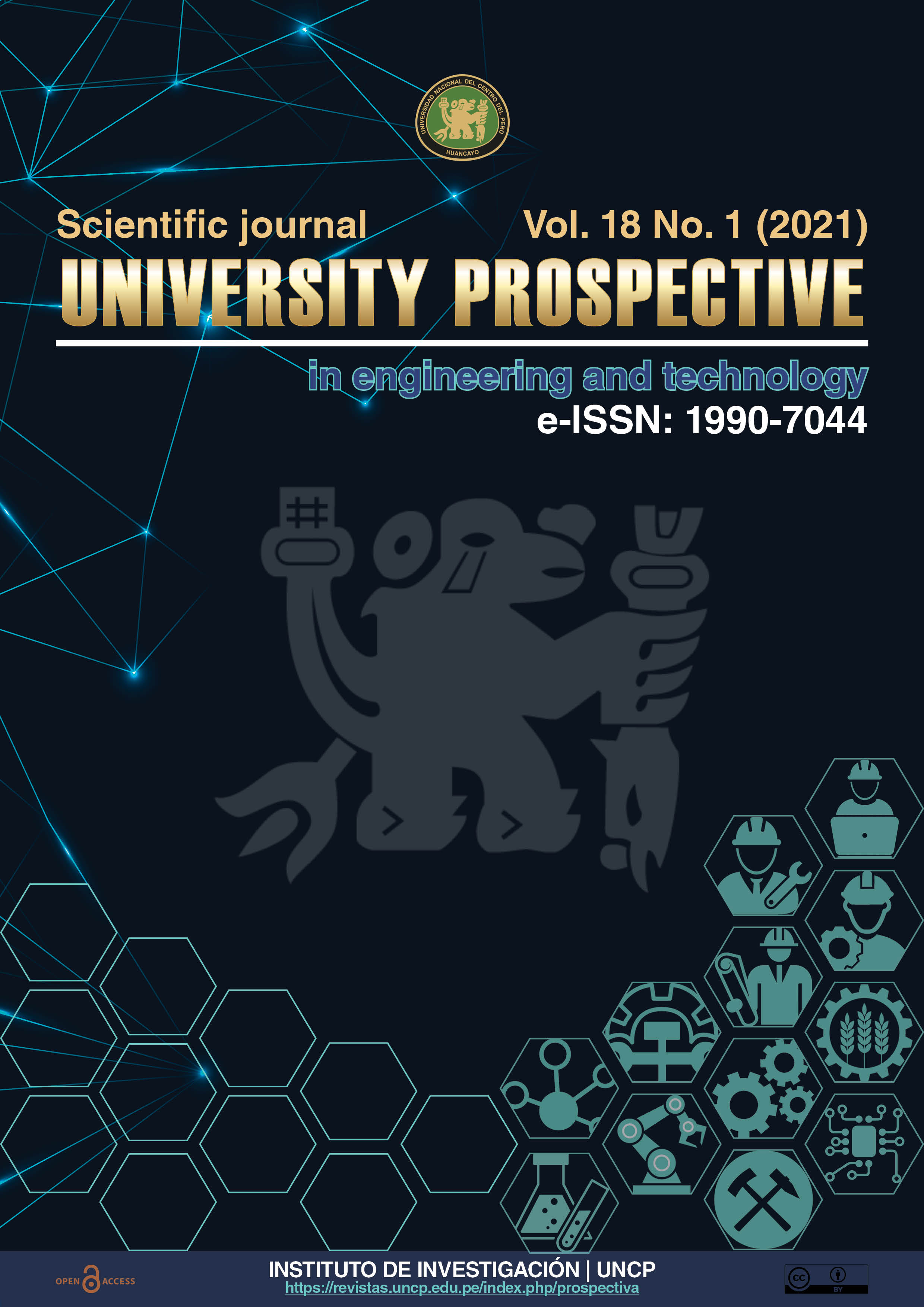Conceptual design of a solar receiver to generate water vapor in dish parabolic concentrators
DOI:
https://doi.org/10.26490/uncp.prospectivauniversitaria.2021.18.1419Keywords:
Solar receiver, Parabolic disk concentrator, Steam generator, Heat storageAbstract
Massive energy generation requires the management of large amounts of water vapor, because heat has to be introduced that allows the temperature to be raised above 1000 °C to generate superheated steam capable of moving generators to produce electricity; for example, The technology of Disk Parabolic Concentrators. In this sense, is not yet mature enough, but it is promising, because studies have shown that the parabolic disk collector system is more efficient, stable, predictable and reliable than other systems, because it concentrates solar energy in a receiver that it assimilates and then offers the possibility of storing it for then continue to use it in about 7 hours, which cannot be said about other systems not foreseen for energy storage or with highly polluting energy deposits such as photovoltaic energy. In this work, the solar receiver is proposed together with its storage system, because all the concentrated energy is managed there and where the efficiency of the entire system is determined, it is a critical process. The objective of this work has been to develop conceptually an optimal proposal taking into account materials, conditions and configurations that have been studied and in which it has finally been concluded that they are advantageous. All this, has been done through the VDI 2221 design methodology that has helped to order the process and get the appropriate data. The design of a more optimal conceptual system has been obtained according to the most recent information, achieving the best efficiency, the most optimal configuration and not losing sight of the duration of the system, avoiding thermal and hand stress to avoid materials with a high carbon footprint, as much as possible.
Downloads
References
Ávila Marín, A. L. (2011). Volumetric receivers in Solar Thermal Power Plants with Central Receiver System technology: A review. Solar Energy, 85(5), 891–910. https://doi.org/10.1016/j.solener.2011.02.002
Boerema, N.; Morrison, G.; Taylor, R. & Rosengarten, G. (2013). High temperature solar termal central-receiver billboard design. Solar Energy, 97, 356–368. https://doi.org/10.1016/j.solener.2013.09.008
Chen, S.; Li, W. & Yan, F. (2020). Thermal performance analysis of a porous solar cavity receiver. Renewable Energy, 156(16), 558–569. https://doi.org/10.1016/j.renene.2016.12.102
Dutta, P. (2017). High temperature solar receiver and termal storage systems. Applied Thermal Engineering, 124, 624–632. https://doi.org/10.1016/j.applthermaleng.2017.06.028
Espinoza, C. A. (2013). Design methods in mechanical engineering. Atlantic International University Honolulu, Hawaii.
Fang, J.; Zhang, C.; Tu, N.; Wei, J. & Wan, Z. (2021). Thermal characteristics and thermal stress analysis of a superheated water/steam solar cavity receiver under non-uniform concentrated solar irradiation. Applied Thermal Engineering, 183. https://doi.org/10.1016/j.applthermaleng.2020.116234
Lai, C. S. & Locatelli, G. (2021). Economic and financial appraisal of novel large-scale energy storage technologies. Energy, 214. https://doi.org/10.1016/j.energy.2020.118954
Lovegrove, K. & Stein, W. (2020). Concentrating Solar Power Technologogy - Índice (Second Edi). Woodhead Publishingv-Elsevier. https://www.sciencedirect.com/book/9780128199701/concentrating-solar-power-technology
Pacio, J. & Wetzel, T. (2013). Assessment of liquid metal technology status and research paths for their use as efficient heat transfer fluids in solar central receiver systems. Solar Energy, 93, 11–22. https://doi.org/10.1016/j.solener.2013.03.025
Regin, A. F.; Solanki, S. C. & Saini, J. S. (2007). Heat transfer characteristics of thermal energy storage system using PCM capsules: A review. Renewable and Sustainable Energy Reviews, 12(9), 2438–2458. https://doi.org/10.1016/j.rser.2007.06.009
Downloads
Published
Issue
Section
License
Copyright (c) 2021 Carlos Sixto Martínez Carrera

This work is licensed under a Creative Commons Attribution-NonCommercial-ShareAlike 4.0 International License.
Esta Revista es de acceso abierto a su contenido a través del Internet, poniendo a disposición de la comunidad científica los resultados de la investigación, de manera gratuita, para el intercambio del conocimiento desarrollado.
El contenidos de la Revista se distribuyen bajo la licencia Creative Commons Reconocimiento-NoComercial-CompartirIgual 4.0 Internacional.
![IconJournalPU [ENG] by Edgar Julian-Laime®](https://revistas.uncp.edu.pe/public/journals/1/pageHeaderLogoImage_en.png)









